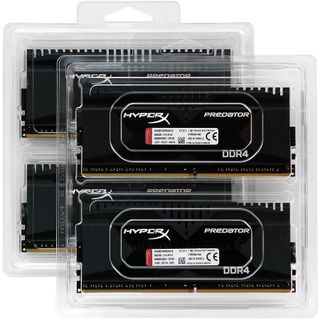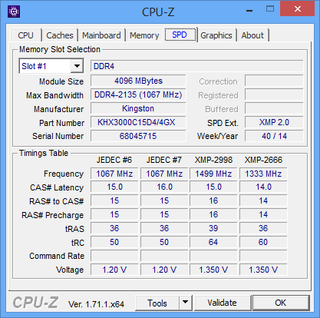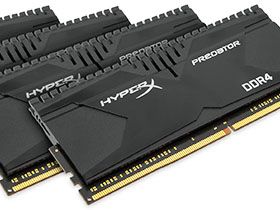Early Verdict
While we continue to use the best-of-the-best in our overclocking analysis, buyers looking for value in the DDR4-3000 market will be far happier with Kingston’s lower-priced HyperX Predator HX430C15PB2K4/16.
Pros
- +
Ultra-fast DDR4-3000 primary data rate, high-compatibility DDR4-2666 secondary data rate, sub-$400 price.
Cons
- -
Slower timings compared to higher-priced parts at the same data rate.
Why you can trust Tom's Hardware
Enthusiast-Class DDR4 At The Same Speed And A Lower Price?
I’ve been using a single kit of DDR4-3000 to test the memory overclocking capabilities of various motherboards since Intel first launched its X99 platform. But is it time for a change? On one hand, getting more performance from lower-cost parts is part of the fun of overclocking. On the other, some enthusiasts are willing to lay down fat stacks of cash just to claim title to the world’s fastest personal computer. There are even power users jockeying for lower rungs on that ladder just to beat all of their friends.

From a reviewer’s perspective, Kingston’s HyperX Predator needs to be either faster than the part it replaces or just as fast, but cheaper, in order to justify its role as a replacement on my motherboard test bench. While faster is nice, I’m always anxious to find better value in less expensive parts that deliver comparable levels of performance, too.
Rated Specifications
Though it has the same data rate and capacity, Kingston’s part number HX430C15PB2K4/16 does face a small obstacle in its potential role as my top overclocking choice: its its XMP-3000 rating starts with 15-16-16-39 timings. The stuff I’m already using is rated at XMP-3000 15-15-15-35.

A second XMP value could make it optimal for comparing alternative DDR4-2666, however, and that same DDR4-2666 CAS 14 value is particularly useful on motherboards unable to operate at DDR4-3000. That includes most of the boards we’ve tested to date. Still, we hold out hope that future firmware development paves the way for higher stable data rates.
Current page: Enthusiast-Class DDR4 At The Same Speed And A Lower Price?
Next Page Overclocking, Tuning, Bandwidth And Latency-
exroofer Your benchmarks compare the DDR4 ram to other DDR4 ram.Reply
Is there a way for you to give us any kind of number comparing it to fast DDR3 CL9 ram? I know you can't do apples to apples benchmarking, but some idea of the performance increase, if any. would be more helpful I would think. -
Crashman Reply
Due to the different CPU, the only thing you can really compare to DDR3 articles is Sandra Memory Bandwidth. It's lower for DDR4, even when set to similar timings at the same frequencies. This is mostly due to longer secondary and tertiary timings, it appears, and will only be solved as DDR4 continues to get faster and lower-latency versions.15011569 said:Your benchmarks compare the DDR4 ram to other DDR4 ram.
Is there a way for you to give us any kind of number comparing it to fast DDR3 CL9 ram? I know you can't do apples to apples benchmarking, but some idea of the performance increase, if any. would be more helpful I would think.
-
Crashman Pricing update at the end of the article. Expect more pricing volatility by the end of this month.Reply -
TerryFawkes Again, DDR3 to DDR4 gaming comparison is what everybody wants.Reply
Fudge the CPUs then (down-clock if needed), get as similar CPUs as possible, or use two high end CPUs that make the two systems GPU bound hence making the difference in CPUs irrelevant.
I'm beginning to get this feeling that there is no performance improvement between DDR3 and DDR4, and that there might even be a performance decrease in DDR4 when it comes to gaming because of the crappy DDR4 latency. And I think that because of this, sites that receive a DDR4 sample to test are told not to test against DDR3 (or no sample for you!)
Sooner or later, somebody will do this test, and we'll then learn the truth which the ddr4 manufacturers don't want us to know.
-
Eggz @TerryFawkesReply
Linus already did it. Take a look: https://www.youtube.com/watch?v=utWnjA4NzSA
He just disabled come of the cores on an X99 chip and clocked them the same. Not 100% identical, but very (very) close. -
g-unit1111 That is one gigantic heat sink on those RAM chips. I'm taking it conventional cooling won't work with those heat sinks as tall as they are?Reply -
Crashman Reply
too many factors to consider (whether the inner slots will be filled, how close the closest-filled slot is, etc. But for huge coolers that overlap the DIMMs, no.15015814 said:That is one gigantic heat sink on those RAM chips. I'm taking it conventional cooling won't work with those heat sinks as tall as they are?
-
SteelCity1981 well this is why you don't adopt to the new gen ram as soon as it comes out because of the high cost and high latency.Reply -
Hupiscratch It's amazing to see how fast these things became. I'm still using a PC with DDR 516 that gets only to about 2.3 GB/s. I think my head will blow when I finally buy a new PC.Reply




